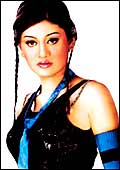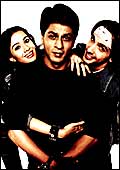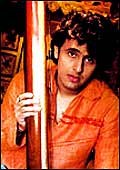|
When
Keshav Jadhav, a 20-something janitor at an apartment complex in
central Mumbai saunters in to work on any given morning, he looks
no different from the brat pack gracing the scenes in the latest
Bollywood blockbuster and by that logic no different from his more
fortunate contemporaries lolling about in college campuses. Fake
Adidas T, ditto for the shoes, 'boot cut' low-rise jeans and a cap
worn (peak facing backwards) complete the picture of cool. In minutes
though he is in regulation blue uniform, mop in hand, enquiring
about leaky drainpipes.
It is no different with Akram Khan, a youngster
working at a stitching unit in suburban Mumbai. With a salary of
Rs 3,500 a month, he keeps aside enough for food and rent, then
scours roadside stalls selling cheap couture for the latest cuts
and styles. His friend Imran, who mans one such roadside stall selling
every style conceivable in blue denim at a starting price of Rs
100, is himself clad in flared black jeans, crisp white shirt and
purple sunglasses pushed back on his head. "I've given up wearing
those stitched trousers," he states pointing to a passerby.
"It's important to look with it."
|
HIGH STREET VS MASS MARKET
|
| LOW-RISE JEANS |
|
| Wrangler (Rs 995-1,500) |
Imitation (Rs 200) |
| Levi's (Rs 999-2000) |
Imitation (Rs 200) |
| Lee (Rs 1,099-1799) |
Unbranded (Rs 100) |
| HAIR COLOURANTS |
|
| L'Oreal Excellence (Rs 399) |
Unbranded (Rs 18) |
| Garnier Colour Naturals (Rs 99) |
|
| NAIL POLISH |
|
Lakme (Rs 55 onwards)
Elle 18 (Rs 20 onwards) |
Chinese brands
(Rs 10 onwards) |
| BODY GLITTER |
|
| Store brands (Rs 135 onwards) |
Unbranded (Rs 10) |
| ANKLE LENGTH CRUSHED SKIRTS |
| Store brands (Rs 450) |
Unbranded (Rs 100) |
| DESIGNER FOOTWEAR |
|
Store brands
(Rs 600 onwards) |
Unbranded
(Rs 100 onwards) |
| FLOATERS |
|
| Nike (Rs 900) |
Unbranded (Rs 75) |
| T-SHIRTS |
|
| Polo (Rs 350 onwards) |
Imitation (Rs 100) |
| Lee (Rs 399-700) |
Imitation (Rs 100) |
| |
Imitation Adidas (Rs 49) |
|
|
As for the clothes Imran peddles, he may not
know their 'English' names, but that hardly bothers him or his customers.
"Do you want to see some 'monkeywash' or 'jhalar' jeans?"
he enquires referring to sandblasted jeans (the reference to the
monkey obviously comes from the brown shade) and cowboy style denim
with tassels running down the sides ('jhalar' is tassels in street
speak). Karim, at the next shop does one better, "how about
these 'anti-fitting', 'cheetah wash' or 'monkey tubelight' pairs?"
he says. Monkey Tubelight? "Oh, those are the ones with huge
white patches that Salman Khan wears all the time," he offers
helpfully, referring to one of Bollywood's biggest stars. He helpfully
adds that newcomer Zayed Khan inspires anti-fit jeans and Shah Rukh
Khan, "the fastest selling-it is called patch wash." For
the record, Karim sells about 25 pairs of high-fashion jeans priced
at anything between Rs 100 and Rs 250 a day at his stall in downtown
Mumbai.
This is a story about how fashion is no longer
the prerogative of high-income households, about how couture has
turned de rigeur for just about everybody. It is a story about hairstyles,
clothes, accessories, footwear (Kavita, a household help in downtown
Mumbai has just invested in a pair of pink platform heels and a
pair of Osho style flats with sequins), hair colour (a quick glance
around the second class ladies compartment of a Mumbai local makes
you wonder if anybody wears their hair black anymore), even body
glitter (this hot selling fashion accessory is available for as
low as Rs 10 per tube).
The influence of films and tele-serials coupled
with the explosion in the retail sector, higher disposable incomes
and, of course, cheap surrogates have together unleashed a new fashion-crazy
being who is fairly ubiquitous on the urban landscape today.
 |
| The fashion shown in risqué music
video remixes is essentially meant to capture the irreverent
attitude of youth. Irreverent or not, it has served to take
fashion, like the thong on the lady pictured alongside, mass. |
Changing Styles
The most arresting feature in all of this is
the sheer speed at which fashion travels to the streets. "We
get new stock the day of the release of a new movie here,"
says a roadside jeans vendor gesturing to the Eros cinema hall featuring
a hit Bollywood film across the road. "Sometimes, even the
previous day," he adds.
"Fashion spreads so fast that it hardly
gets on the ramp and you see it on the streets-in fact, sometimes
you see it on the streets even before it makes it to the ramp in
India since it was probably part of the previous season in Europe
and the export surpluses make it to the streets," says Mumbai-based
designer Krishna Mehta. "To top it all, it penetrates the market
at dirt cheap rates."
"Over the last year or year-and-a-half,
we find that the domestic demand for very cheap fashion has simply
surged and local manufacturers seem to have realised that the lower
end market particularly is doing exceedingly well," says Renuka
Vaswani, Head of merchandising at Alisha Garments, a leading export
house.
Advertisers have been quick to catch the trend.
"For the last year or so, we have been following a uniform
portrayal of characters in our ads," explains Prasoon Joshi,
National Creative Director, McCann Erickson. "A pair of boot
cut jeans and crushed cotton shirt, for instance, cuts across consumer
segments today. Very specifically, Bollywood is the biggest influencer
and you only need to watch out for what Salman Khan or Vivek Oberoi
are wearing to put your finger on the pulse."
 The
fashion shown in risqué music video remixes
is essentially meant to capture the irreverent attitude
of youth. Irreverent or not, it has served to take fashion,
like the thong on the lady pictured alongside, mass. The
fashion shown in risqué music video remixes
is essentially meant to capture the irreverent attitude
of youth. Irreverent or not, it has served to take fashion,
like the thong on the lady pictured alongside, mass. |
Channels like MTV have got the mass segment
figured out to the last T. "We live at a time when imagery
is everything. We deliberately retain the veneer of sec a (the highest
economic strata) in the channel though 80 per cent of our programming
is in Hindi, since that is (sec a) the aspirational element. The
VJs have to have a certain look in order to retain that aspirational
element," says Cyrus Oshidar, Creative Head, MTV.
The phenomenon isn't just about commerce; it
is nothing short of a major sociological shift. "Identities
are increasingly being defined by an accumulation of signs,"
says Dr Anjali Monteiro, Professor and Head of Media Studies at
the Tata Institute of Social Sciences. "Today, the signs can
be accessed by anyone-it could be a cheap cellular phone or fake
accessories, but wearing the sign is most important."
Bollywood has always influenced fashion in
the mass market; now, the couture factor has pushed out the kitschy
costumes of the 1990s and transformed Bollywood heroines into aspirational
figures for the higher economic classes as well. "Today, Bollywood
influences fashion for the masses as well as the classes" says
Manish Malhotra, the designer for a string of Bollywood hits ranging
from the hugely successful Shah Rukh Khan starrer, Kuch Kuch Hota
Hai, to the more recent Rani Mukherji starrer, Hum Tum. "I
do a lot of non-resident Indian wedding gear and believe me, Bollywood
is the benchmark," he adds.
 Bollywood
actors like Salman Khan and Vivek Oberoi serve as fashion influencers
across audience segments. Others like Zayed Khan propel specific
categories like anti-fit jeans while stars like Shah Rukh Khan
and Saif Ali Khan are drivers for the best selling low rise,
'patch work design' blue jeans. Bollywood
actors like Salman Khan and Vivek Oberoi serve as fashion influencers
across audience segments. Others like Zayed Khan propel specific
categories like anti-fit jeans while stars like Shah Rukh Khan
and Saif Ali Khan are drivers for the best selling low rise,
'patch work design' blue jeans. |
The Price Factor
The mass market for fashion can be penetrated
only through price. A walk down any of the street side shopping
hubs in any Indian metro will establish just how low prices can
fall. A pair of boot-cut low waist jeans can be had for Rs 100,
ankle-length layered peasant style skirts (yes, the sort that models
sport currently) can be had for less than that, crushed cotton shirts
for less than Rs 50, fake Adidas or Nike tees for Rs 49, hair colourants
for less than Rs 20, body glitter for Rs 10 a tube, 'Chinese nail
polish' for Rs 10 a bottle....
Here is how it works. In the apparel business,
all fashion gear finds its genesis in some way or the other in the
export market. With leading fashion labels like Abercrombie &
Smith, Gap, Old Navy and countless others sourcing their wares from
India, a lot of the export surplus (rejects) makes it to the domestic
market. Export reject branded tees and jeans are sold to agents
for as little as Rs 40, says one exporter. However, that is not
enough to satisfy the sea of demand that has cropped up.
A manufacturer cum vendor reveals a simple
strategy: "Many of us are manufacturers for exporters. We deliberately
overestimate the bale requirement when the order comes in, which
leaves us with hundreds of surplus meters of export quality fabric
that we either sell to agents who then get the stuff stitched or
we just stitch the clothes ourselves, put different brand names
on it and offload it in the market.''
 Game
show hosts like Sonu Nigam and Hussain of
Kisme Kitna Hai Dum (STAR Plus) fame serve as role models and,
therefore, as fashion influencers for the young. Game
show hosts like Sonu Nigam and Hussain of
Kisme Kitna Hai Dum (STAR Plus) fame serve as role models and,
therefore, as fashion influencers for the young. |
 The
single biggest fashion influencer in the 'Indian casuals' category
is the TV serial. Everyone from the "homely"
heroine of Sony's 'Yeh Meri Life Hai' to vamps with halter
neck blouses to the ever popular housewives of Star's Kyunki...,
influences a range of styles, 'necklines' and accessories for
the mass market. The
single biggest fashion influencer in the 'Indian casuals' category
is the TV serial. Everyone from the "homely"
heroine of Sony's 'Yeh Meri Life Hai' to vamps with halter
neck blouses to the ever popular housewives of Star's Kyunki...,
influences a range of styles, 'necklines' and accessories for
the mass market. |
"You can never trace these stocks back
to any single source" says a leading exporter. "Often
agents just come by and pick up stacks of surplus labels from us,
these are obviously getting stitched on to stitched fabric.'' The
reference point for the designs is obviously the export market.
In categories like shoes, cosmetics and some
other forms of apparel, imports from China and South East Asian
countries has caused a shift in the market. "Chinese imports
have changed the tastes of the Indian public," says Mohammad
Khan whose 'One Dollar Shop' in central Mumbai stocks only imports
from China and Thailand. At a neighbouring shop, cosmetics salesman
Ketan Shah says that Chinese imports in nail polish and hair colour
are considerably cheaper than the Indian brands.
The Marketing Challenge
There is clearly a humungous opportunity for
a host of branded players to tap this consumer segment. A clear
indication in the apparel category is denims, where the value for
money fashion category (jeans priced between Rs 350 and Rs 700)
sees the fastest growth in the sector at 50 per cent per annum while
the super premium category (Rs 1,000 and above) is growing at 25
per cent, according to Janani Subramaniam, Brand Manager, Wrangler,
at Arvind Brands. Brands like Newport, Ruff and Tuff, Flying Machine
and Killer already operate in this segment.
The story is quite different with cosmetics
where Anil Chopra, Head of Lakme Lever, explains that the growth
is still in the premium segment that grows at 20 per cent per annum
vis-a-vis a sectoral growth of 12-14 per cent. The reason for the
sluggish growth for entry-level brands is simply that entry-level
offerings of leading brands like Lakme sell for about five times
the going-rate of low-priced competitors. That's a story that is
repeated in the case of shoes too.
 The
Bollywood heroine is now portrayed as someone who can appeal
to the "masses as well as classes". Key influencers
of fashion like Rani Mukherji, Preity Zinta and Aishwarya Rai
are robed for the screen by professional designers. The wedding
costume genre is a rage. The
Bollywood heroine is now portrayed as someone who can appeal
to the "masses as well as classes". Key influencers
of fashion like Rani Mukherji, Preity Zinta and Aishwarya Rai
are robed for the screen by professional designers. The wedding
costume genre is a rage. |
 Music
channels' English speaking, designer gear
donning VJs serve as aspirational hooks for the mass
market. With 80 per cent of its programming in Hindi, MTV talks
directly to young consumers in the mass market, albeit with
a "veneer of SEC A". Music
channels' English speaking, designer gear
donning VJs serve as aspirational hooks for the mass
market. With 80 per cent of its programming in Hindi, MTV talks
directly to young consumers in the mass market, albeit with
a "veneer of SEC A". |
The absolute necessity to correct this anomaly
is highlighted by a few simple statistics: in the denim and tees
categories, 50 per cent of the market is unorganised while in categories
like cosmetics the corresponding proportion is a whopping 70 per
cent.
Large players like L'Oreal in the hair colourants
segment have already introduced products for various consumer segments,
but the cheapest is still a steep Rs 99. The company, however, is
not perturbed by the possibility of more brands crowding the market.
In fact, it could be a sign that the market is developing says a
spokesperson.
The other challenge for marketers is quite
simply the ability to keep high-street fashion ahead of street fashion,
especially since prices on the high street are already seeing an
impact. "Typically, we would need to price fashion higher,
but we believe that we offer value for money and we need to keep
the prices at the levels that we do in order to see volumes,"
says Beena Mirchandani, Head (Merchandising), Pantaloons. "It's
just going to keep getting worse everyday, but then this what markets
for fashion go through internationally; we will just have to keep
running to stay ahead," adds designer Mehta.
She is right. It is definitely going to get
worse, particularly for big brands and designers alike. Just wait
till a smart start-up launches branded nail polish sachets at Re
1 or hair colour sachets at Rs 5 or branded jeans at Rs 100. That
should set the cat among pigeons.
|
